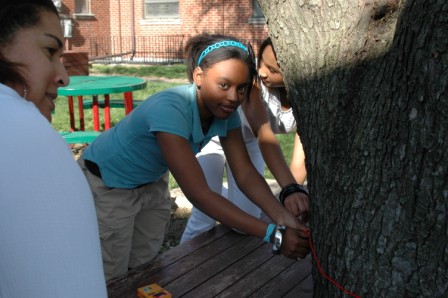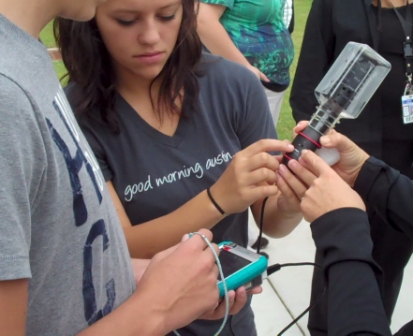
According to the most widely-accepted definition, STEM education is an interdisciplinary approach to learning where rigorous academic concepts are coupled with real-world lessons as students apply science, technology, engineering, and mathematics in contexts that make connections between school, community, work, and the global enterprise.[1]
While not specifically designed as a STEM curriculum, PLT fits this definition remarkably well. As an environmental education program, PLT also emphasizes an interdisciplinary approach to learning. It incorporates real-world lessons that help students make connections between school, community, and the natural world. In addition, PLT teaches students how to think about complex issues, employing a problem-solving orientation that helps them seek solutions.
PLT Engages Students in STEM Learning
PLT uses instructional strategies that model STEM practices, including hands-on activities, promoting teamwork, building investigation and research skills, problem-solving, and so on.
- For example, try Activity 24, Nature Recyclers from PLT’s PreK-8 Environmental Education Activity Guide to involve teams of students in devising experiments using sow bugs, through which they learn first-hand about the cycling of energy and matter in ecosystems.
 PLT provides instruction that builds on and encourages the natural curiosity of youth. Its interdisciplinary approach helps students experience the world in new ways and encourages them to explore their own questions about it.
PLT provides instruction that builds on and encourages the natural curiosity of youth. Its interdisciplinary approach helps students experience the world in new ways and encourages them to explore their own questions about it.
- For example, let students ask the questions and “learn-by-doing” an environmental improvement project at their school using PLT’s GreenSchools! Investigations.
PLT activities help students see connections among cross-cutting concepts and core disciplinary ideas through real-world investigation and problem-solving.
- For example, ask students to conduct a check-up of trees in their neighborhood using Activity 77, Trees in Trouble from PLT’s PreK-8 Environmental Education Activity Guide. They’ll explore the concept of cause and effect, while also learning about the core idea of growth and development in organisms.
The PLT program reveals the interdependence of the world we inhabit, providing students with an inherent motivation to learn more about it.
- For example, with Activity 48, Field, Forest, and Stream from PLT’s PreK-8 Environmental Education Activity Guide, your students can conduct a field study of three different environments, comparing the soil, temperature, sunlight, and animal and plant life in each.
PLT demonstrates to students how fun and fascinating STEM can be.
- For example, Activity 51, Make Your Own Paper from PLT’s PreK-8 Environmental Education Activity Guide, allows your students to explore the papermaking process using different types of materials and to experience for themselves the amazing way that plant fibers form paper.
Use PLT to Support Your STEM Teaching
Through its high-quality professional development and comprehensive, classroom-tested materials, PLT supports effective STEM teaching. Each PLT activity:
- Specifies the process skills students will practice in the activity, such as analyzing or predicting.
- Offers suggestions for authentic assessment of skills and content.
- Provides background information to bolster teacher understanding of the content.
- Provides step-by-step procedures for leading investigations.
- Identifies potential ways to incorporate technology use in the lesson.
- Includes student pages to support data collection and analysis.
In addition, PLT continually selects resources to help you enhance STEM learning with PLT materials. For example, see the STEM connections and lesson plans that PLT has recently identified to supplement the Energy & Society kit. Also look for the “STEM Connections” column in the The Branch e-Newsletter, which highlights specific ways you can use PLT activities to engage your students in real-world applications of STEM education.
Using PLT and STEM to Reach Diverse and Urban Students
PLT incorporates strategies that are effective in teaching STEM with traditionally underserved populations, including:
- cooperative learning,
- hands-on experiences, and
- relevant and real-world problem-solving.
PLT activities incorporate differentiated instruction techniques so you can readily integrate PLT’s hands-on, investigative pedagogy for a wide range of grade levels, learning styles and abilities. The PreK-8 Environmental Education Activity Guide uses an icon and appendix to easily identify the strategies teachers can apply to differentiate their teaching.
PLT’s GreenSchools! Investigations, in particular, are specifically designed for diverse and urban audiences.These PLT lessons take place right within the school or on the school grounds, and do not mandate a class visit to a wooded area or park. Additionally, the GreenSchools! program helps educators to teach about the environment – and explore STEM learning – using the resources they already have.
Share your Ideas
Do you have a new idea about how PLT can help teach STEM concepts? Please share it below so we can continue learning from each other!
[1] Tsupros, N., Kohler, R., & Hallinen, J. (2009). STEM education: A project to identify the missing components. Intermediate Unit 1: Center for STEM Education and Leonard Gelfand Center for Service Learning and Outreach, Carnegie Mellon University, Pennsylvania.


